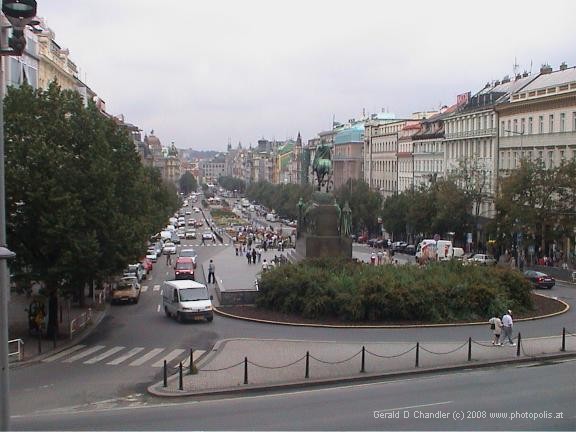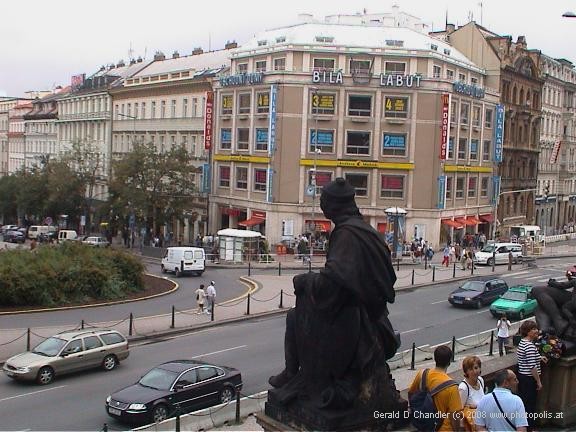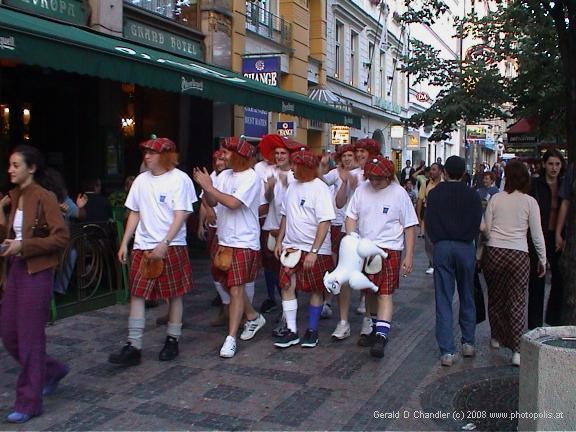Home | Front Page | Index | Blog | New | Contact | Site Map
Prague Intro
Old Town
Charles Bridge
Castle Hill
Josephov
North-East
Wenceslas Square
Vysehrad
Vltava
Foto Show

Egypt
Israel
Turkey
Bulgaria
Romania
Ukraine
Poland
Prague
Britain
USA 2002
Travel Map
When thinking about Wenceslas Square don't be too literal. It is not square at all, but rather a broad avenue about 4/10 mile (700 meters) long. Over the years it has had many changes. Once upon a time people used horses for real work. And, as should be obvious, they bought and sold them. In that day and age the Horse Market was located here. As you visit it, imagine a lot of mud, straw, and horse droppings. With modernization, and as everything got up to date in Kansas City, so did it in Prague. Horses and horse market went, and trams were laid down the middle of the avenue. And then trams went, a greenway was put down the center, and the "square" took its appearance of today.

Wenceslas Square seen from National Museum steps
|
From the steps of the National Museum you get a look down almost the entire length of the square. At the top end is the statue of King Wenceslas on horse back. As Jan remembers it, when she visited in 1968 the square looked closer to a horse market than an upmarket hangout for yuppies. Not really, but it certainly didn't have the wealth and elegance on display that it does now. It was rather bare, and grim looking, covered in grey cobblestones, although part of that may have been the season (November).
If you can, imagine the square filled with nearly half a million people, all protesting the Soviet forced ending of the Prague Spring. This is where it happened. Briefly, the history is as follows: In January, 1968 Alexander Dubcek became General Secretary (head) of the Czechoslovakian Communist Party. Rather quickly he put into place ideas that he had been developing for years. These included almost complete freedom of the press, something absolutely absent in all other eastern European and communist countries. He was called to Moscow by Brezhnew and told to rein in things. When he didn't, the USSR and its "allies" (i.e. satellites) sent masses of tanks and other forces into the country. The peaceful opposition was quashed and freedom was suppressed until the breakup of the Soviet Union and the Warsaw Pact in 1989-91.

Statue outside National Museum and top end of Wenceslas Square |
Outside the National Museum there is a statue that overlooks Wenceslas Square. That is as close as we got to the inside of the Museum. Thus we can't evaluate how good or interesting the collection is.

Brits strolling outside shops facing Wenceslas square |
These guys were part of a football team or something similiar. I didn't talk to them but it was obvious they were enjoying Wenceslas Square. Not shown is the other side of their costume: each one had a plastic sheet over his rear in the form and color of a bare ass.
Lining both sides are plenty of high priced and high quality shops. Most hours of the day the sidewalks team with people. Most of them are tourists, but a few are shills trying to gyp tourists. One of their games is to offer to change money at a particularly good rate and then give a worthless currency that appears to be, but is not Czech money.
The Story of Saint Wenceslas (Svatý Václav)
Nearly every English speaker has heard of "Good King Wenceslas" because of the popular 19th century Christmas carol. Although there have been many Czech/Bohemian kings with this name, he was the first, and the one for whom Wenceslas Square is named.
He was born near Prague about 907 and died in Stará Boleslav, Bohemia in 929. In his brief life, of only 22 years, he obviously impressed himself on his country as he became the patron saint of Bohemia and Moravia,
Wenceslas was raised a Christian by his grandmother St. Ludmila, but his ambitious mother, Drahomíra (Dragomir), a pagan, had Ludmila murdered and acted as regent herself, until Wenceslas came of age in 924 or 925. Her court intrigues and the wishes of the people to end the conflicts between Christian and non-Christian factions in Bohemia led Wenceslas to take the reins of government. As Duke he was pious, reportedly taking the vow of virginity, and encouraged the work of German missionary priests in the Christianization of Bohemia. His zeal in spreading Christianity, however, antagonized his non-Christian opponents.
Faced with German invasions in 929, Wenceslas submitted to the German king Henry I the Fowler. His submission provoked some of the nobles to conspire against him, and they prompted his younger brother, Boleslav (Boleslaus), to murder him. Waylaid by Boleslav en route to mass, Wenceslas was killed at the church door. Frightened by the reports of miracles occurring at Wenceslas' tomb, Boleslav had his remains transferred in 932 to the Church of St. Vitus, Prague, which became a great pilgrimage site during the medieval period. Wenceslas was regarded as Bohemia's patron saint almost immediately after his assassination.